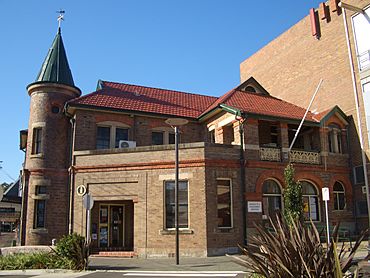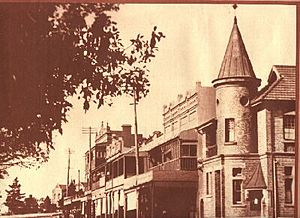Kogarah, New South Wales facts for kids
Quick facts for kids KogarahSydney, New South Wales |
|||||||||||||||
|---|---|---|---|---|---|---|---|---|---|---|---|---|---|---|---|

Kogarah Community Centre
|
|||||||||||||||
| Population | 16,416 (2021 census) | ||||||||||||||
| • Density | 6,310/km2 (16,300/sq mi) | ||||||||||||||
| Established | 1885 | ||||||||||||||
| Postcode(s) | 2217 | ||||||||||||||
| Elevation | 29 m (95 ft) | ||||||||||||||
| Area | 2.6 km2 (1.0 sq mi) | ||||||||||||||
| Location | 14 km (9 mi) south-west of Sydney CBD | ||||||||||||||
| LGA(s) |
|
||||||||||||||
| State electorate(s) |
|
||||||||||||||
| Federal Division(s) | |||||||||||||||
|
|||||||||||||||
Kogarah is a lively suburb in Southern Sydney, Australia. It's about 14 kilometres (9 miles) south-west of the main city centre of Sydney. Many people consider Kogarah to be the heart of the St George area.
Contents
About Kogarah
Kogarah gets its name from Kogarah Bay. This is a small bay located on the northern side of the Georges River. The suburb used to reach all the way to the bay. However, over time, parts of it became separate suburbs. These new areas are now called Kogarah Bay and Beverley Park.
Kogarah is a mix of different areas. You'll find homes, shops, and light industrial businesses here. It's also well-known for having many schools. These include primary schools, high schools, and places for higher education. There are also many health services, like two hospitals and several medical centres. The NRL team, St George Illawarra Dragons, has its Sydney office nearby. Their home ground, Jubilee Oval, is often called Kogarah Oval. Kogarah has all sorts of homes, from small houses to large apartment buildings.
Kogarah's Past
The name Kogarah comes from an Aboriginal word. It means 'rushes' or 'place of reeds'. Over time, the spelling changed a few times. It was written as 'Coggera', 'Cogerah', and 'Kuggerah'. But the spelling 'Kogarah' became official when the railway line was built in the 1880s.
Some of the first land grants in this area were given to John Townson and James Chandler. This was in the early 1800s. The area was important for growing fruit and vegetables. It also provided oysters for Sydney. In 1869, St Paul's Church of England opened. It was built on land given by William Wolfen, who owned a lot of land in Kogarah. The suburb grew around this church and a local hotel called the Gardeners Arms. Kogarah officially became a municipality (a local government area) in 1885.
A part of Kogarah was once a neighbourhood called Moorefield. This land was given to Patrick Moore in 1812 by Governor Lachlan Macquarie. Patrick Moore built a nice house there. Later, in 1888, a horse racing track called Moorefield Racecourse opened. In the 1950s, the Moorefield land was divided up. The Department of Education bought some of it. They built two high schools and a college there. Moorefields Girls High School was built in 1955 on what used to be Moore's farm.
Historic Places
Kogarah has a few places that are listed for their historical importance. One of these is:
- Toomevara Lane: This is where the Toomevara Lane Chinese Market Gardens are located.
Who Lives in Kogarah?
Population Facts
| Historical population | ||
|---|---|---|
| Year | Pop. | ±% |
| 2001 | 10,843 | — |
| 2006 | 11,715 | +8.0% |
| 2011 | 12,764 | +9.0% |
| 2016 | 15,124 | +18.5% |
| 2021 | 16,416 | +8.5% |
In 2021, the Australian Bureau of Statistics did a Census. It found that 16,416 people lived in Kogarah. About 36% of these people were born in Australia. Many other residents were born in countries like Nepal (11.3%), China (8.2%), India (6.0%), the Philippines (3.9%), and Bangladesh (2.9%).
While 30.4% of people spoke only English at home, many other languages are also spoken. These include Nepali (11.6%), Mandarin (7.8%), Cantonese (5.3%), Greek (4.8%), and Bengali (3.7%). This shows that Kogarah is a very diverse community!
Famous People from Kogarah
Many well-known people have connections to Kogarah:
- Dave Brown – a rugby league star from the 1930s, born in Kogarah.
- Ray Burton – a musician, singer, and songwriter known around the world.
- Reg Gasnier – a legendary rugby league player who lived in Kogarah.
- Clive James – a famous writer, poet, and commentator, born and grew up in Kogarah.
- Ronald Sharp – a notable Australian organ builder, born in Kogarah.
- Kenneth Slessor – one of Australia's greatest poets, went to Kogarah Primary School.
- Steve Smith – a former captain of the Australian national cricket team, born and grew up in Kogarah.
- Henry Thornton – a cricketer, born and grew up in Kogarah.
- Brandon Wakeham – a rugby league player, born and grew up in Kogarah.
- Sam Konstas – a Test cricketer.
Getting Around
Kogarah railway station is an important transport hub. It's on the Illawarra line and serves the suburb of Kogarah. You can catch Sydney Trains T4 line services from here.
Schools and Churches
Schools in Kogarah
Kogarah has many schools for different ages:
- Kogarah Public School
- Kogarah High School
- James Cook Boys Technology High School
- Moorefield Girls High School
- St Declan’s Catholic Primary School
- St George Girls High School
- St Patrick's Primary School (for both boys and girls)
- Marist College Kogarah (a secondary school for boys)
- Sydney Institute of TAFE: St. George Campus (for further education and training)
Churches in Kogarah
There are also many different churches in Kogarah:
- Resurrection of Christ Greek Orthodox Church
- Grace Chinese Christian Church
- Kogarah Soldiers' Memorial Presbyterian Church (Kirkplace)
- St Patrick's Catholic Church
- St Paul's Anglican Church
- Christ Church St George (Anglican), and Church in the Bank (Anglican)
- Christ Living Church (Indonesian Church)
- Kogarah Uniting Church
Images for kids





